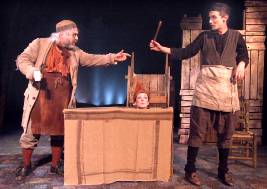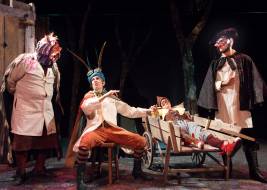
The Adventures Of Pinocchio and Deaf West Theatre prove a match made in Family Theater Heaven in the company’s 20th Anniversary Season production of the classic children’s tale.
Performed Commedia dell-Arte style, Lee Hall’s delightful adaptation of Carlo Callodi’s 1883 novel might in other hands than Deaf West’s be strictly for children (with accompanying parents along for the ride). Because it’s a Deaf West production, though, there’s no need for adults to have kids in tow in order to relish the cleverness of an approach which mixes deaf, hard-of-hearing, and hearing actors in a variety of ingenious combinations.
Most if not all of the novel’s favorite characters are present, from the titular puppet to his woodcarver father Geppetto to the Talking Cricket to the Puppetmaster to the Fox and the Cat to the Fairy With Turquoise Hair to the Owl and the Crow to Pinocchio’s naughty schoolmates to those play-addicted boys turned into donkeys and sold as circus animals.
What makes Deaf West’s Pinocchio so very special (in addition to a clever script and some gorgeous, creative designs) are the many ways director Stephen Rothman has come up with to create an experience that audience members can enjoy equally regardless of hearing ability.
There are characters who speak (and have a Signer shadowing them), there are characters who sign (and have an ever-present Voice by their side), and there are characters who speak and sign simultaneously … all of whom get put together in various ingenious configurations.
When Pinocchio and Geppetto share the stage, there’s a signing Pinocchio (Amber Zion) with voice provided by an onstage Darrin Revitz, and a talking Geppetto (Matthew Henerson) with ASL provided by an onstage Colin O’Brien-Lux. Fox and Cat are both played by signing actors (Vae [her full name] and Lexi Merman), with James Royce Edwards and Lindsay V. Evans providing their voices. Henerson and O’Brien-Lux also team up to speak and sign as the Puppetmaster and the Owl, with O’Brien-Lux, a hearing actor who’s also a “native signer,” doing some speaking-&-signing ensemble characters to boot. Tommy Korn appears as a number of signing characters (Pantaloon, Bird, Raven, and Lampwick), their voices provided by both Edwards and Evans. Vae appears as the Talking Cricket with Evans doing the voice, but it’s Edwards (doubling as a class dunce) who provides Vae’s voice when she’s portraying the schoolmarm. Royce and Evans both have a couple of roles where they speak and sign, and hearing-impaired Marman does voice and ASL too as Girl (aka the Blue Fairy).
Confused? You won’t be when you see how well this all works as performed by The Adventures Of Pinocchio’s multitalented cast.
Director Rothman and dramatist Hall set the clever, tongue-in-cheek mood from the get-go, with Geppetto beginning his “Once Upon A Time” tale facing away from the audience, then (realizing that not all out there are hearing), starts yelling out the words. Finally, realizing that he’s going to need an assistant, the woodcarver brings out his signer.
Later on, there’s a moment where Geppetto starts talking to a Pinocchio whose back is turned towards the woodcarver—until his signer points out to him that he’s going to have to get Pinocchio to face him if he wants the boy to know he’s being spoken to.
Hands and arms are used in imaginative ways—inside the block of wood that becomes Pinocchio, as the flames which burn Pinocchio’s feet off, and as the “voice” of a talking bird perched atop a door.
There are numerous cute moments that both children and adults will relish, as when we learn that the Puppetmaster sneezes whenever he gets sentimental, Pinocchio’s sad tale getting him sentimental (and sneezing) more than a few times. Another one has Pinocchio telling of his misadventures (“And then … and then …”) and ending up with a deliciously unexpected “And then—it’s now!” At one point, Pinocchio starts running away, only to have his voice shout out “Wait for me!”
Hall’s script is full of delightful bits of dialog. When Pinocchio comes across yet another creature, this time a yellow bird, he complains, “Hey, I’m sick of talking animals!” When the schoolteacher asks Pinocchio what the letter A stands for, Pinocchio responds, “A…n elephant?” A line to the song “Playland” describes a place “where you can kick the teacher whenever you want.” And when Pinocchio finds himself turning into a donkey, he’s told he’s suffering from “Jackass fever. It happens to all the boys.”
The entire cast shine, with Zion and Revitz combining talents to make for an absolutely adorable Pinocchio, Revitz giving the precocious puppet the cutest of voices to match Zion’s enchanting facial expressions and gestures. All the rest—Edwards, Evans, Korn, Henerson, Marman, O’Brien-Lux, and the one-named Vae—do couldn’t-be-more-inspired work, creating clearly distinct characters and/or voices and displaying razor-sharp comic timing. Musical theater stars Revitz and Edwards get to perform several original songs as well.
Evan Bartoletti’s fanciful scenic design, James L. Moody’s colorful, varied lighting, Joe Cerqua’s first-rate sound design and musical compositions, Carol F. Doran’s inventive makeup, hair, and wigs, and Alexandra Dunn’s ingenious properties all make for a storybook-ready design package, which also includes some splendid shadow effects on the upstage scrim (as when Pinocchio is swallowed by the whale). Still, the indisputable design star of the show is Ovation Award-winning costumer Ann Closs-Farley, who has not only created Commedia-inspired feats of color and imagination but has designed each costume in pairs, a more detailed one for each character’s principal performer and a second one, suggestive of the first, for the character’s double, whether Voice or Signer. The overall result of these combined talents is as visually exciting an intimate theater design as you’re likely to see all year.
Linda Bove is ASL master, Jason Dino technical director, and William Coiner production stage manager. Laura Hill is producer, David Kurs associate producer, and casting is by Michael Donovan, CSA.
As Deaf West heads towards its third decade of providing performing opportunities for the deaf and hard-of-hearing as well as theatrical productions accessible to deaf, hard of hearing, and hearing patrons, The Adventures Of Pinocchio is sure to introduce the company to whole new audiences of families with children in addition to their usual kids-free adult crowds, all of whom are sure to delight in its multitude of wonders.
Deaf West Theatre, 5112 Lankershim Boulevard, North Hollywood. Through March 26.
www.DeafWest.org
–Steven Stanley
February 25, 2011
Photos: Ed Krieger





 Since 2007, Steven Stanley's StageSceneLA.com has spotlighted the best in Southern California theater via reviews, interviews, and its annual StageSceneLA Scenies.
Since 2007, Steven Stanley's StageSceneLA.com has spotlighted the best in Southern California theater via reviews, interviews, and its annual StageSceneLA Scenies.







 COPYRIGHT 2024 STEVEN STANLEY :: DESIGN BY
COPYRIGHT 2024 STEVEN STANLEY :: DESIGN BY